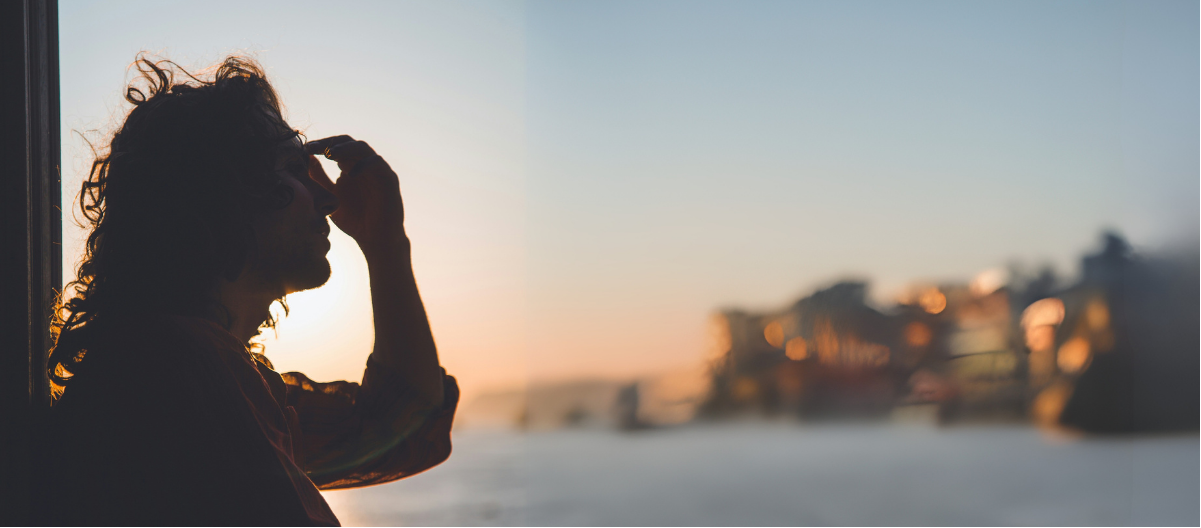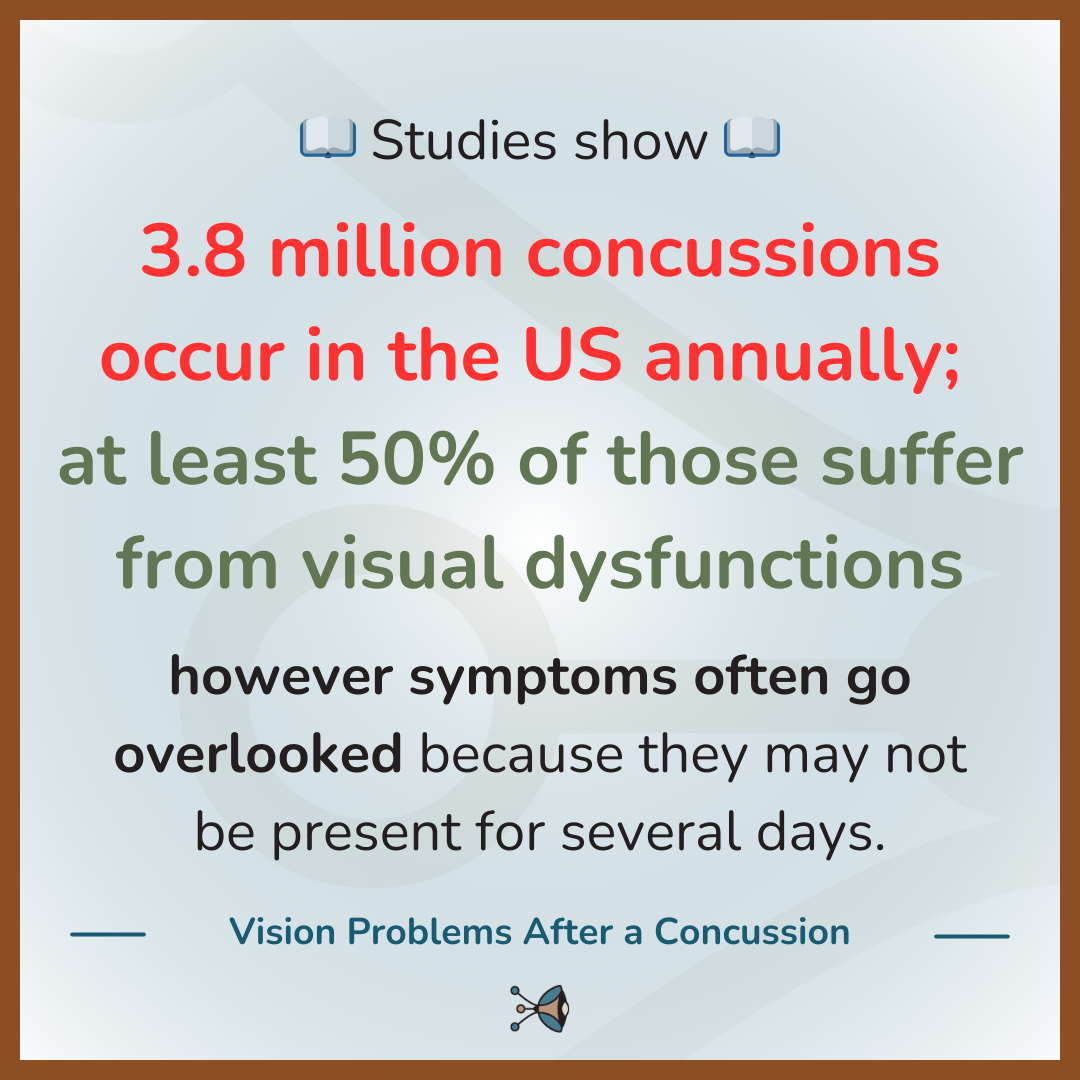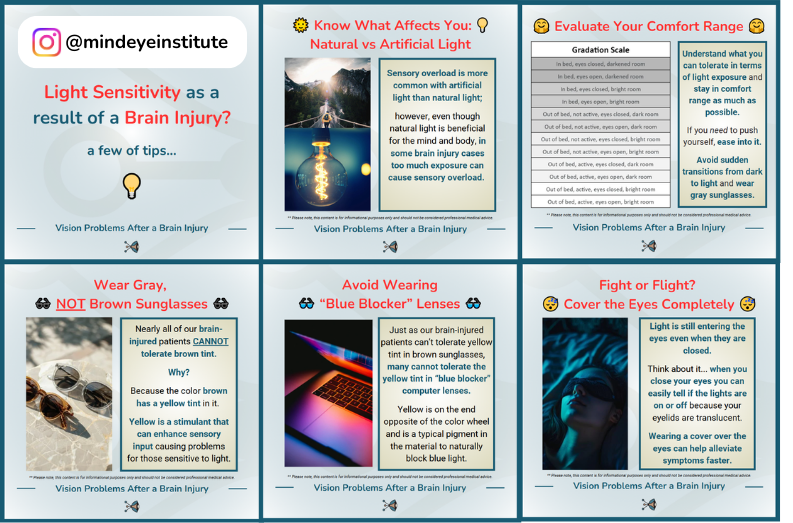Key Takeaways
- Light sensitivity & sound sensitivity often stem from brain signal disruptions
- These sensitivities can cause anxiety, depression, and isolation
- Traditional solutions offer temporary relief but don't address the root cause
- Mind-Eye Institute uses neuro-optometric lenses to stimulate the brain and restore sensory processing
- 87% of compliant Mind-Eye patients improved light sensitivity since 2022
- 88% of compliant Mind-Eye patients improved sound sensitivity since 2022

The soft glow of a bedroom lamp suddenly seems much too bright. Images emanating from television and computer screens become painful to the eyes. Once loved music is now intolerable noise. What has happened?
Disruptions of light and sound signaling circuits in the brain and over-sensitization of the body’s central nervous system can lead to photophobia (hypersensitivity to light) and sound irritation (phonophobia), including sound sensitivity with pain (hyperacusis) and misophonia (sounds that elicit strong reactions like anger or disgust). Because multiple causative factors, including traumatic brain injuries and concussions, underly these conditions, such sensitivities are not uncommon among the general population and are often termed “neurological conditions.”
Common Causes of Photophobia and Phonophobia
Migraine, tension, and other chronic headaches and post-concussive syndrome – the panoply of symptoms that develop following concussion and traumatic brain injury – play major roles in development of abnormal reactions to light and sound. Other culprits are autism spectrum disorders, attention deficit hyperactivity disorder (ADHD), stroke, fibromyalgia, tinnitus (constant ringing or buzzing in the ears), glaucoma, corneal and retinal diseases, Meniere’s disease, sensory processing abnormalities, depression and anxiety and mood disorders.
Unfortunately, sensitivities to light and sound are not benign conditions. Patients struggle with their effects.
In a study published in a 2021 edition of the journal Children, experts contend that chronic headache disorders are prevalent in the population, with about 60 percent of youth and adults experiencing them at some point in their lives. Such headaches may cause significant disabilities and are triggers for abnormal reactions to light and sound. These sensitivities “typically occur in response to non-noxious stimuli and contribute greatly to the headache experience. One proposed mechanism for the presence of these atypical sensory sensitivities in adult headache patients is central sensitization of the nervous system. Importantly, recent evidence does support the presence of central sensitization in youth with chronic headaches,” the scientists state.

Meanwhile, authors of an online article for the American Occupational Therapy Association (AOTA) quote the Centers for Disease Control and Prevention in estimating up to 3.8 million concussions occur annually in the U.S. Concussions are mild traumatic brain injuries. But even mild head injuries can give rise to a host of symptoms, such as memory impairment, brain fog, fatigue, chronic headaches, concentration difficulties, sleep disturbances, visual processing problems, spatial mapping disturbance, and, of course, light, and sound sensitivities.
These same AOTA writers say scientists report a finding that 59 percent of concussion patients “experience some level of noise sensitivity, and nearly half [struggle with] aural symptoms beyond six years.”
Not Just Physical! Light, Sound Sensitivities Affect Mental Health
Although no exact statistics currently exist, experts believe millions of people live with light or sound sensitivities and phobias. Some studies suggest at least 25 percent of those with a level of photophobia “believe their light sensitivity has had a notable impact on their quality of life,” according to TheraSpecs representatives.
“A recurring theme from photophobic patients is the idea of returning to a ‘normal’ life. Sensitivity to light can incite anxiety in people such that they avoid situations or activities that could trigger it, [namely] going into grocery stores or shopping malls, engaging in outdoor activities, [including] concerts and sporting events.” Oftentimes, the “extreme” reaction to photophobia is “retreating into complete darkness. It’s why people who experience this painful sensitivity often refer to themselves as vampires who are forced to shun the light that hurts so much,” TheraSpecs author write.
“Sensitivity to light can incite anxiety such that they avoid situations or activities that could trigger it...
...going into grocery stores or shopping malls, engaging in outdoor activities, etc." —TheraSpecs Author
Research has offered evidence that exposure to irritating levels of light among patients with light sensitivity can affect emotions, eliciting fear, anger, frustration and irritability. If it becomes chronic, photophobia and phonophobia can promote anxiety, feelings of hopelessness and helplessness, and depression.
Note that photophobia does not cause blindness and phonophobia does not result in deafness, but both conditions may be symptoms of diseases that can cause permanent sensory damage.
Why Light and Sound Sensitivities Often Develop Together
Experts list approximately 50 medical and neurological disorders responsible for potential development of abnormal sensitivity to light and sound. Although a person can develop either a light or a sound sensitivity, these two sensory issues often occur in tandem. An online article on the TheraSpecs web site offers a reason why for their co-existence. The author writes: a “primary effect” of many causative physical and mental conditions is the impairment of the central nervous system, “which is responsible for how we interpret our surroundings…This [impairment] can create a myriad of reactions that characterize [both] photophobia and/or phonophobia, namely:
Stronger negative responses to environmental stimuli…
A reduced overall tolerance for light and sound, making even appropriate levels seem excessive or even painful.
Overstimulation of the brain, causing an inability to correctly process one’s surroundings, which may also be compounded by psychological distress.”
It is through the senses – especially, sight and hearing – that the brain receives information about the world and determines a person’s reactions to it. In the case of light and sound sensitivities, “signals are not being inhibited by [the brain’s] ganglia and cerebellum,” neurologists say. “This causes the brain to act in an ‘irrational way,’ resulting in an overload of information and activating pain centers.”
In another online article, the writer explains:
“The eyes and ears are two of the five senses we rely upon to take in information about our environment. Our eyes contain light-sensitive cells called rods and cones that help us perceive light, color, and movement. The rods and cones of the eyes send signals to neurons, which transmit information about what we’re seeing to the brain. This process, known as retinal processing, can be…complicated by intense light.
The same goes for sound waves that enter our ears: they pass through the outer ear and then travel to hair cells in the cochlea in the inner ear. These hair cells convert sound waves into electrical signals that are then sent to the brain via neurons. All of this information is constantly being processed and relayed, making it possible for us to perceive our environment.” Sound sensitivity can occur when this normal process is disrupted by injury or disease.
A University of Illinois at Chicago College of Medicine study, published in the Proceedings of the National Academy of Sciences and discussed in an online article by sciencedaily, determined that “just as the brain adjusts the sensitivity of retinal cells in the eye to light, it may also modulate the sensitivity of hair cells in the inner ear to sound and head position.”
The hypothesis suggests the follow-up assumption that brain injury and neurological disease can disrupt how hair cells inside the ear communicate with the brain in managing sound and head position.
Sensitivity Triggers for Patients to Avoid
Scientists and health professionals often describe patients’ abnormal reactions to light and sound as irritations or sensitivities. However, sensitivities are more likely an outgrowth of shorter-term, acute medical conditions, like dry eye, eye inflammation, corneal disease, blepharospasm, and eye-related surgical or laser procedures in the case of light and infections of the inner ear and instances of vertigo in terms of sound. Even certain medications, prescribed for diabetes, epilepsy, and other conditions, can precipitate sound and light sensitivities.
On the other hand, phobias – photophobia, phonophobia, and misphonia – denote reactions to light and sound that are often painful and usually stem from chronic disorders and trauma, such as brain injuries, Lyme disease, and Meniere’s disease.
“Phobias denote reactions to light and sound that are often painful and usually stem from chronic disorders and trauma."
Symptom triggers for photophobic patients include exposure to fluorescent lights and the blue light emanating from computer screens, mobile phones, tablets, television, and other electronic devices, as well as relatively bright sunlight. Headaches – migraine or tension – also can promote or intensify photophobia.
For patients who react abnormally to sound, triggers may be loud music, the hustle and bustle of movement and chatting in stores or restaurants, nearby conversations, even the crackling of paper and plastic food bags, running water from a faucet or the simple act of closing a door. Oftentimes, these sounds elicit a startle reflex – patients jump at what others consider to be a normal part of everyday activities in the surrounding environment.
Treatments
Treatments for light and sound sensitivities vary from comprehensive to band-aid approaches depending on the extent of the problem. Ready, at-hand solutions include:
Using glasses that limit sun glare and broad brimmed hats that shade the eyes when outdoors.
Reducing screen time on computers and other electronic devices.
Adjusting lighting emanating from electronic screens.
Remaining in dark rooms or in areas with subdued lighting.
Relying more on the natural, outdoor light filtering inside than electric or LED lights whenever possible.
Avoiding fluorescent lighting.
Undergoing electrical nerve stimulation in situations warranting it.
Wearing noise-cancelling headphones and other devices.
Even acupuncture and relaxation techniques have been proposed in some instances to quiet sensory irritation, but scientists contend not enough research has been conducted to determine the effectiveness of these techniques. Experts do warn not to relay on wearing dark glasses indoors or remain for overly extended periods in darkened rooms, since these approaches may only increase a person’s sensitivity to light.
Of course, for many patients, resolving the acute, underlying medical condition that gave rise to a sound or light sensitivity – dry eye, corneal disease, or inner-ear infection, for example – will eliminate the problem. Changing an individual’s medications also can prove a ready solution.

What Happens When Light and Sound Become Chronic – Like After Concussion or Brain Injury?
What happens if light and sound phobias are the result of more chronic issues, such as traumatic brain injury (TBI), concussion, autism, or ADHD, which are not readily treated or resolved?
A 2021 study in the Chinese Medical Journal suggests light therapy (heliotherapy) – controlled exposure to daylight or artificial light – may be effective in easing the progression and symptoms, including light and sound sensitivities, of a broad range of neurodegenerative disorders. Neurodegenerative disease can affect both the central ,and peripheral nervous system.

Another study, this one in the journal Clinical Practice and Epidemiology in Mental Health, reports “brain stimulation by light and sound” can be combined with [other] therapies to combat depression and anxiety states.” Both mental states often lead to light and sound sensitivities.
Of course, studies have not shown any of these treatments to be guaranteed effective for relieving patients with chronic light and sound sensitivities or phobias or helping them return to more “normal” lives. And no person wants to live the rest of his or her life wearing hats and dark glasses and avoiding family fun events, shops and restaurants, and other venues.
Is there hope for “normal.?” The Mind-Eye Institute may have the answer.
Mind-Eye Institute: Practicing Innovative Neuroscience

In the vanguard of neuroscience research, clinical practice, and education is the Mind-Eye Institute, located in the Chicago suburb of Northbrook, Illinois. Its successes in applying the principles of advanced neuro-optometric science to relieve post-concussive symptoms and the neurological effects of traumatic brain injury, stroke, neurological disease, and learning disorders like autism spectrum disorders, ADHD, and dyslexia have earned it international recognition.
Specifically, under the direction of its founder and executive director of research, Deborah Zelinsky OD, the Institute conducts comprehensive testing of patients complaining of light and sound sensitivity and other neurological symptoms, such as sleep disorders, impaired memory, brain fog and concentration difficulties. Following this unique testing protocol, Mind-Eye optometrists prescribe highly individualized, therapeutic eyeglasses, lenses, and filters designed to modify the amount, angle, and intensity of light passing through the retina – a process known as retinal stimulation or retinal neuromodulation.
The retina is a key part of the central nervous system. Mind-Eye Institute eyeglass prescriptions are intended to emphasize peripheral processing rather than central eyesight and to make positive changes in injured and diseased brains or brains with underdeveloped learning skills.
Optometrists at the Institute explain that altering the way light enters the retina:
Creates changes in brain activity by often mitigating symptoms from traumatic head injury, concussion, stroke, or neurological disorders. These symptoms include light and sound phobias and sensitivities, visual processing disorders, headaches, brain fog, concentration and attention problems, sleep difficulties, even balance and mobility challenges.
Oftentimes proves effective in building undeveloped visual processing skills in children – and adults – with autism spectrum disorder, attention deficit hyperactivity disorder, and other learning difficulties.
Modifies some internal systems that regulate metabolism, motor control, posture, mood, circadian rhythm, and decision-making abilities, among other processes.
Supports the Mind-Eye Institute’s overall goal of using advanced optometric neuroscience to resynchronize a patient’s sensory inputs, especially the link between eyesight and hearing, thereby enhancing a patient’s quality of life and helping improve perception of his/her surrounding world.
Many grateful patients call what the Institute does “magic.” But “it is not magic,” says Dr. Zelinsky. “It is advanced neuro-optometric science. What we are about is returning patients to quality lives.”
If you suffer from chronic light and sound irritations, check out the Mind-Eye Institute.
Real Patient Application
Sound just plain hurt. So much so that Diane Field sometimes lost the ability to speak in the presence of overwhelming noise and required assistance of a service dog trained to “interrupt” what she refers to as “intermittent auditory and visual overload” -- even while riding the train to work.
But then she found the Mind-Eye Institute.
Relevant Research
Page [tcb_pagination_current_page] of [tcb_pagination_total_pages]
Interested in learning more?
At the Mind-Eye Institute we understand that interactions between the electrical and biochemical pathways in the brain affect physical, physiological and psychological systems. Visual interventions that alter retinal signaling pathways impact both the electrical and biochemical systems.
To learn about next steps for registering as a patient or registering a child as a patient, please call the Mind-Eye Institute office at 847.558.7817 or you can fill out our online New Patient Inquiry Form provided here.

